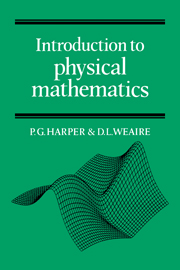Book contents
- Frontmatter
- Contents
- Preface
- Some notes on notation
- 1 Introduction
- 2 Errors
- 3 Cartesian coordinates
- 4 Vectors
- 5 The scalar product
- 6 The vector product and rotation
- 7 Matrices in physics
- 8 The transformation of matrices
- 9 The matrix eigenvalue equation
- 10 Exponential and logarithm functions
- 11 Sine and cosine functions
- 12 Graph plotting and curve sketching
- 13 Differentiation
- 14 Approximations
- 15 Power series and Taylor's expansion
- 16 Partial differentiation
- 17 Integration
- 18 The differential equation
- 19 Solving first-order differential equations
- 20 Second-order differential equations
- 21 Solving second-order differential equations
- 22 The complex exponential
- 23 The circuit equation
- 24 Harmonics and Fourier series
- 25 The diffusion equation
- 26 Waves
- 27 The rate of change of a vector
- 28 The scalar field and gradient operator
- 29 The vector field
- 30 Line integration
- 31 The potential field
- 32 Surface and volume integration
- 33 Flux and divergence
- 34 Circulation and the curl
- 35 Conclusion
- 36 Miscellaneous exercises
- Index
2 - Errors
Published online by Cambridge University Press: 20 October 2009
- Frontmatter
- Contents
- Preface
- Some notes on notation
- 1 Introduction
- 2 Errors
- 3 Cartesian coordinates
- 4 Vectors
- 5 The scalar product
- 6 The vector product and rotation
- 7 Matrices in physics
- 8 The transformation of matrices
- 9 The matrix eigenvalue equation
- 10 Exponential and logarithm functions
- 11 Sine and cosine functions
- 12 Graph plotting and curve sketching
- 13 Differentiation
- 14 Approximations
- 15 Power series and Taylor's expansion
- 16 Partial differentiation
- 17 Integration
- 18 The differential equation
- 19 Solving first-order differential equations
- 20 Second-order differential equations
- 21 Solving second-order differential equations
- 22 The complex exponential
- 23 The circuit equation
- 24 Harmonics and Fourier series
- 25 The diffusion equation
- 26 Waves
- 27 The rate of change of a vector
- 28 The scalar field and gradient operator
- 29 The vector field
- 30 Line integration
- 31 The potential field
- 32 Surface and volume integration
- 33 Flux and divergence
- 34 Circulation and the curl
- 35 Conclusion
- 36 Miscellaneous exercises
- Index
Summary
Physical scientists use a lot of common sense and only a little statistics in dealing with errors. Only in special areas (such as the work of Standards Laboratories) are errors relentlessly pursued with full rigour. Usually, it is enough to be satisfied that they are negligible or insignificant for the purposes at hand. As with safety regulations, one tries to ensure a large ‘margin of error’ wherever possible. This contrasts with the state of affairs in biology and in social sciences. These deal in quantities, such as the frequency of the human heartbeat, so widely variable that errors must be treated with caution and proper statistical methodology. But even common sense needs a little mathematical background, such as is given here.
First, we may distinguish between random and systematic errors. A systematic error is one which is consistent from one measurement to the next. It might arise from inaccurate adjustment of instruments, a faulty calibration, the ineptitude of the scientist himself, or simply from a failure to recognise some influence upon the data which was not the object of the experiment. We can try to identify such errors and either eliminate them or add corrections to allow for them, whereupon they no longer concern us. It is not usual to include systematic errors in an error estimate since, if we can identify them, they can be removed!
- Type
- Chapter
- Information
- Introduction to Physical Mathematics , pp. 5 - 16Publisher: Cambridge University PressPrint publication year: 1985

